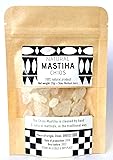All Categories





Chios Mastiha Pack 60gr (2.11 oz) Small Tears Gum 100% Pure Mastic Gum From Mastic Growers Fresh
Share Tweet
Get it between 2024-12-09 to 2024-12-16. Additional 3 business days for provincial shipping.
*Price and Stocks may change without prior notice
*Packaging of actual item may differ from photo shown
- Electrical items MAY be 110 volts.
- 7 Day Return Policy
- All products are genuine and original
- Cash On Delivery/Cash Upon Pickup Available








Chios Mastiha Pack 60gr (2.11 oz) Small Tears Gum Features
-
Mastiha gum, Masticha, mastica, mastix or mastixa.mastic gum is unique in the world! Real mastic is only produced in the south part of Chios Island. It comes from the mastic tree, without any industrial intervention. Chios gum Masticha is hand cleaned piece by piece. It is rare and unique, full of miraculous properties that made Hios mastic gum so much sought after
-
Mastiha gradually loses its colour and after a long time it can appear yellowish or even yellow, something which is clearly due to its oxidation. Keeping it refrigerated (ideally) can slow down this process. But even when oxidized, it is absolutely safe despite being degraded
-
The best mastiha for chewing is a combination of hard and soft tears that prevent it from being sticky on the teeth and make it agreeably chewable. It needs patience, though, because at the beginning the sensation is unusual and the taste rather bitter.
-
Pure Mastic of Chios is gluten free
About Chios Mastiha Pack 60gr (2.11 Oz) Small Tears Gum
Mastic is a 100% pure product. That means that NOT all the pieces of mastic (or tears as they are called) are the same. Some pieces are bigger, some are smaller, some are harder and some are softer. · Mastic -due to temperature- is softer in summer and harder in winter. · Usually larger pieces are softer than the smaller ones which dry out and harden faster. · Generally, medium or large pieces are better for chewing and small pieces are better for grounding them into powder. A more yellow color means older and harder mastic, a more whitish color means fresher and softer mastic.Chios island is home to mastiha also known as mastic. But why is mastiha so special? Mastiha is basically a resin from the mastiha trees and appears in drops. While the mastiha trees may grow in other areas in the Mediterranean and produce resin, only trees in Chios produce the mastiha “tears” that have the characteristic aroma, taste and health benefits.Mastic collection starts usually mid August, with the work starting again very early in the morning. The larger pieces are collected (along with dust, tree leaves and small stones) from the ground. They are spread in large wooden pans and taken in to the growers house to be stored in a dry and cool place. The cleaning of mastic is a laborious task which starts November. Usually the family participates and the cleaning process lasts throughout the winter period. Mastic is washed and then the larger pieces are manually cleaned one by one with a small pointed knife.





















